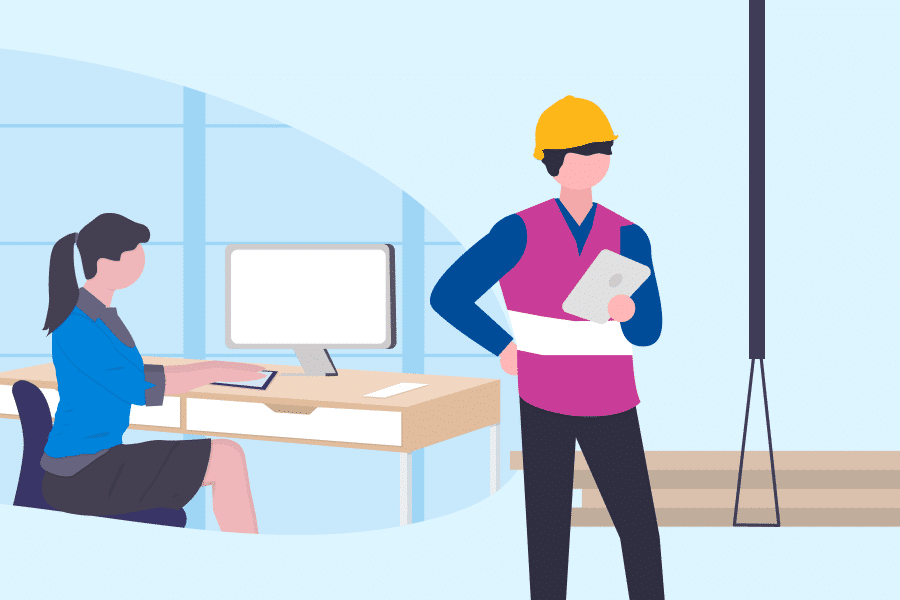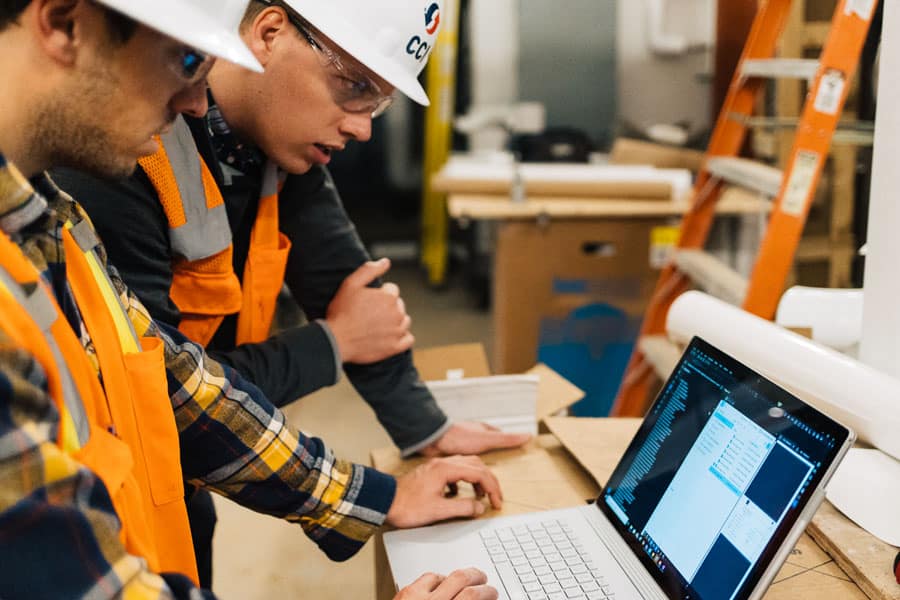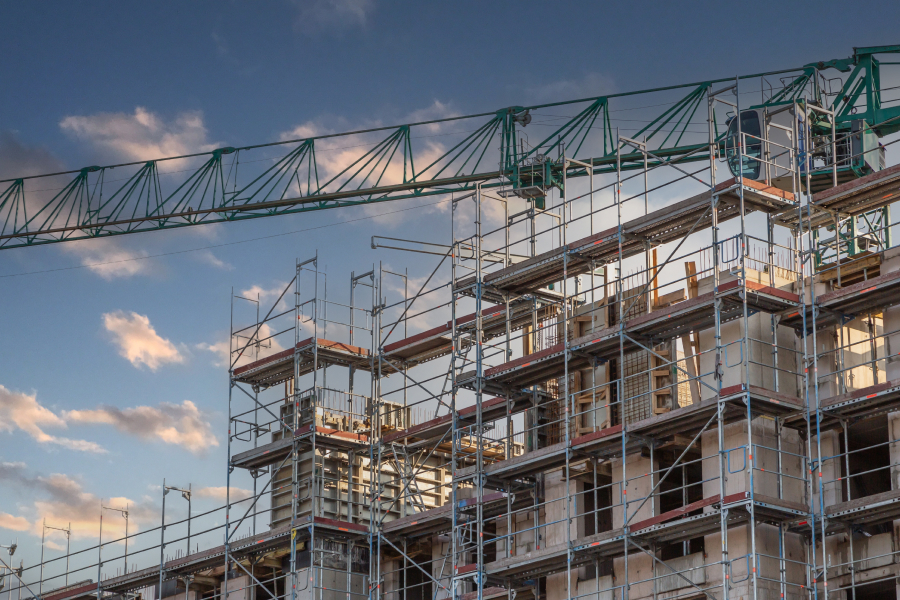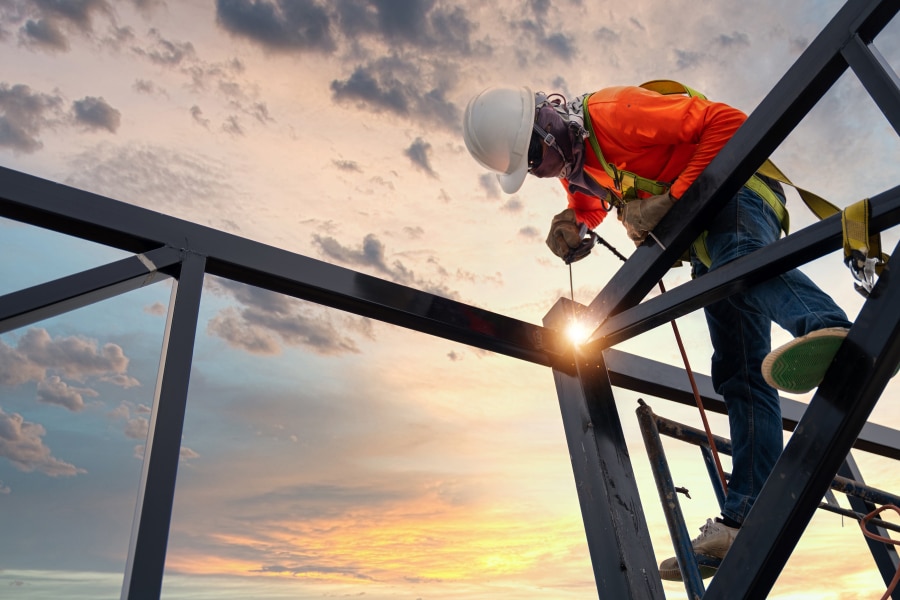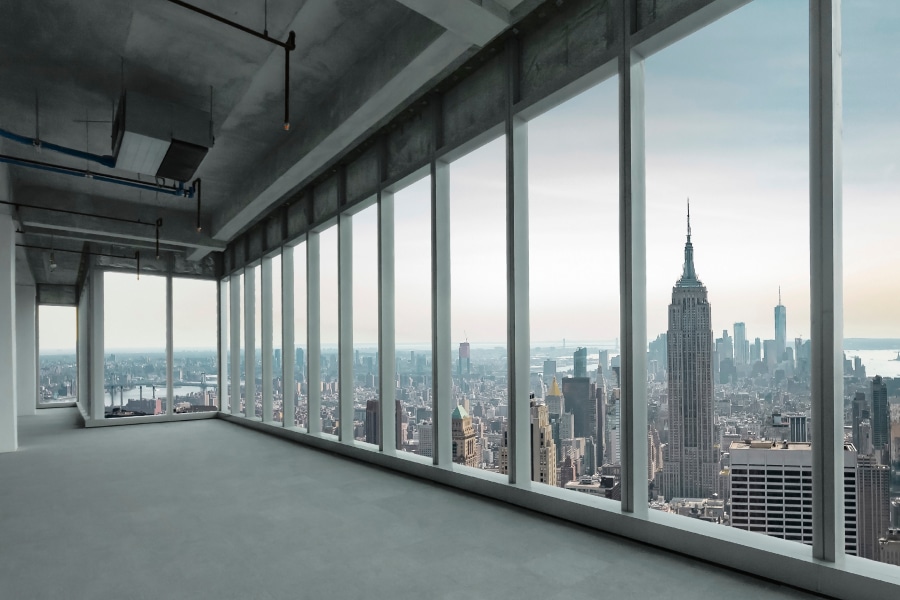The construction industry, made up of mostly small to medium-sized businesses, is a slow adopter of new technologies. Innovation is much more than futuristic tech; it includes harnessing tools now that enhance processes, products and services, building consistency and accuracy, saving time and improving the bottom line.
Future-proof your construction business
The three major roadblocks preventing construction companies from becoming more competitive include:
- Non-digitised processes that jeopardise the ability to access consistent and ready-to-use data (paper-based documentation).
- Project execution that is decentralised and deployment that depends on the project managers.
- Each project being perceived as unique, meaning standardising documentation and processes simply isn’t effective.
Five trends shaping the construction industry into the future
Consider how your business will respond to common challenges and shifts to help you to build a sustainable competitive advantage. These include:
- Upskilling, training and skills shortages
- Gender equality in construction
- Increasing costs and supply chain issues
- Productivity management
- Waste management
Importantly, landmark projects across all states have been fast-tracked, meaning that the work brought forward should be expected to leave a dip in construction in the not-too-distant future. Construction businesses should be leveraging ways to reap the rewards of some of the following government infrastructure priorities:
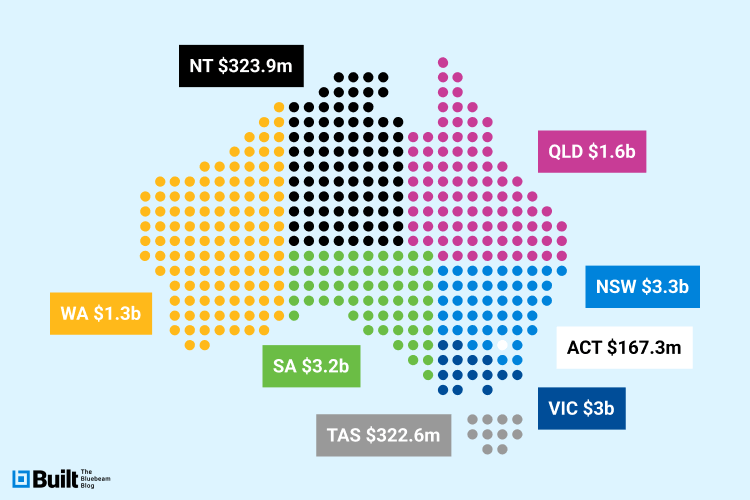
Queensland: $1.6 billion, including:
- $400 million into the Bruce Highway
- $240 million for the Cairns Western Arterial Road Duplication
- $464 million for additional road safety and community infrastructure projects
Northern Territory: $323.9 million, including:
- $173 million for the Northern Territory Gas Industry Roads upgrades
- $150 million in Northern Territory National Network Highway upgrades
- $77.1 million for additional road safety and community infrastructure projects
Western Australia: $1.3 billion, including:
- $237 million towards METRONET works at Hamilton Street and Wharf Street
- $200 million in Great Eastern Highway upgrades
- $288 million for additional road safety and community infrastructure projects.
New South Wales: $3.3 billion for projects, including:
- $2 billion for upgrades to the Great Western Highway between Katoomba and Lithgow
- $500 million for Princes Highway Corridor upgrades
- $548.5 million for additional road safety and community infrastructure projects
Australian Capital Territory: $167.3 million for projects, including:
- $132 million for Canberra Light Rail – Stage 2A
- $26 million for the William Hovell Drive Duplication
- $18.9 million for additional road safety and community infrastructure projects
South Australia: $3.2 billion for projects, including:
- $2.6 billion for the North-South Corridor – Darlington to Anzac Highway
- $148 million for Stage 2 of the Augusta Highway Duplication
- Plus $173.9 million for additional road safety and community infrastructure projects
Victoria: $3 billion for projects, including:
- $2 billion for the Melbourne Intermodal Terminal
- $380 million for the Pakenham Roads upgrade
- $250 million for Monash Roads upgrades
- $373 million for additional road safety and community infrastructure projects
Tasmania: $322.6 million for projects, including:
- $113 million for Midland Highway Upgrades
- $80 million for the Bass Highway Safety and Freight Efficiency Upgrades Package
- $54 million for additional road safety and community infrastructure projects
Trend 1: Construction industry upskilling, training and skills shortages
More stringent building compliance requirements, an ageing workforce and a diminishing number of new entrants into the construction workforce has placed the industry under stress, meaning an active focus is required to attract and retain talent to meet the demand for construction services.
Although the industry is yet to experience significant digital disruption, major technological advances in everyday digital technology, automation for lower-skilled jobs, building information modelling (BIM), and prefabrication will require the workforce to be trained, re-trained and upskilled for the new jobs and tasks required.
Ongoing learning and development through events, workshops and new resources are essential for you to future-proof your construction workforce and business.
More jobs need more people
is one of four industries that will collectively contribute 62.1% of Australian employment growth in the five-year period to May 2024. To successfully deliver this, the construction industry needs to be equipped with the capability and tools to meet emergent trends and challenges.
Emerging workforce skills include those which harness new technologies as well as those that focus on retaining past value, such as heritage skills. Traditional heritage skills are performed by traditional trades (known as traditional building trades or preservation trades) who actively practice their craft in respect of historic preservation, heritage conservation, or the conserving and maintenance of the existing built environment.
Stay up to date on emergent skills requirements
Prefabrication is one area gaining more acceptance in Australia and will require construction workers with different skill sets. There are a few ways you can keep your teams up to date.
Micro-credentialing and life-long learning: Skill sets could be used for professional development, allowing workers to upskill, learning how to use new tools, techniques or technologies, or move to a related field of employment.
Trade specialisation: Construction businesses are typically small-scale with 20 employees or less, meaning a multiskilled workforce is worth its weight in gold. However, it may be a challenge to develop apprentices to deliver the full range of skilling opportunities that are needed to fulfil the requirements of a traditional apprenticeship.
Compliance and regulation training: The National Construction Code (NCC) is the building and plumbing code that incorporates all on-site construction requirements into a single code. Recent failures in building performance and issues of non-conforming materials and building products have highlighted the problems of buildings not conforming to the standards outlined in the NCC. The Code offers a range of professional development courses and recognised credentials to support the development and compliance of industry practitioners – offering recognised credentials in key construction activities.
Skills gaps in construction
Job vacancy data has revealed that the top requested skills by employers were soft skills such as communication and planning. The data also highlights the urgent need for tools to enable and streamline processes within the project delivery team.
According to the Construction, Plumbing and Services IRC’s Skills Forecast the top generic skills required for the construction industry include:
- Language, literacy and numeracy (LLN)
- Learning agility/information literacy/intellectual autonomy and self-management
- Design mindset/thinking critically/system thinking/solving problems
- Communication/virtual collaboration/social intelligence
- Technology
Trend 2: Gender equality in construction
As a growth industry requiring diverse skill sets, the construction industry urgently needs to address gender inequality within its ranks. At this time, however, about 9 out of 10 workers in the industry are male.
Construction remains one of the most male-dominated industries in the world, with female participation remaining stubbornly sluggish since the 1990s:
“Although some women work in construction and building companies in Australia, very few are in management or leading roles,” University of Sydney researcher and academic Dr Marzena Baker said
Dr Baker recommends that construction businesses implement a tailored approach towards building workplace equality.
“Instead of ignoring demographics and the identity of women by treating all employees the same, construction organisations could achieve greater equality by developing specific and tailored means of attracting, retaining and promoting women,” she said.
Diversity Equals Opportunity
Gender equality is not just about “smashing through the concrete wall”. Global recruitment firm Ranstad lists a series of critical benefits for employers who invest in a diverse workforce:
- Build your workforce numbers to stem the flow of upcoming retirements
- Better reflect your customers’ needs and values
- Position your business to win key tenders, contracts, grants and awards
- Boost your productivity and innovation
- Become recognised and valued as a diverse employer to attract greater talent
To be recognised and valued as an employer that has a diverse workforce the answer doesn’t just lie in the weekly pay packet. You should think about how to offer meaningful work that is supported by learning and development and includes opportunities for career progression.
Recognising the pivotal role that the construction industry plays in the national economy, support towards workforce diversification is also driven by industry bodies and across various state governments.
Extra support to build gender equity into your construction workforce
The Victorian Government’s Women in Construction Strategy, in partnership with the Building Industry Consultative Council, is focused on removing barriers and putting in place practical measures to improve female participation and retention within the construction industry. Some of these measures include:
- Training and development pathways
- Financial aid and study scholarships
- Mentorship and network support to build retention
- Introduction of workplace practices to support flexibility
Meanwhile, the NSW government has announced it will support 3,000 training places for women in trades to help boost female representation in construction, manufacturing, engineering, transport and logistics.
The fee-free Built for Women training program will target women aged 16 to 24, female jobseekers, women at risk of unemployment and women in receipt of Commonwealth benefits.
Geo Lee, NSW Minister for Skills and Tertiary Education said the program would help boost numbers of women working on building sites.
“There has never been a better time to reskill or up-skill and take advantage of the employment opportunities arising from the NSW government’s record $107 billion infrastructure investment, which is creating hundreds of jobs”.
Mr Geo Lee
“Growing housing developments, new road and infrastructure upgrades as well as the new Western Sydney airport are creating skills demands in manufacturing, engineering and transport and logistics, providing an opportunity for women to increase their skills and participation in the industry.” The Women Building Australia program, delivered by Master Builders Australia, also works to attract and support women who are seeking to enter and progress career opportunities in the building and construction sector. The program features a range of activities including career expos, a business resilience and coaching program, a national mentoring program and more.
Trend 3: Increasing construction costs and supply chain issues
“The world emerging from the global pandemic is very different to the one that entered it. Now as the post-pandemic recovery gets underway, world leaders are calling for the coming years to be more than just a period of growth, but of renewal and positive change too. Governments around the globe have called on the construction sector to step up and serve as an engine of wider economic growth.”
Neil Bullen, Global Managing Director Real Estate, Turner and Townsend.
Data from ResearchandMarkets.com confirms that in mid-June 2020, the government announced that 15 infrastructure projects worth AUD72 billion (US$49.1 billion) will be fast-tracked, supporting over 60,000 direct and indirect jobs.
“Moreover, the federal, state and territory governments have reached an agreement to cut approval time for infrastructure projects by half. In the fiscal year (FY) 2020/2021 (July to June) budget, announced in early October 2020, the government announced plans to invest AUD7.5 billion on transport infrastructure projects across Australia, bringing the federal government’s total commitment to infrastructure projects since the onset of the pandemic to AUD14 billion (US$9.5 billion) over the next four years,” the Australian Construction Industry Report 2021 advised.
Supply chain uncertainty
While stepping up to the challenge, as well as responding to record government infrastructure spending across Australia, construction companies now have to contend with uncertain supply chains. Supply chain disruptions are a global issue, affecting the delivery and cost of raw materials, equipment, product and the resulting scope creep these external threats bring to the industry.
The Australian Industry Group (Ai Group) Construction Supply Chain Council has been formed in a bid to build a collective voice to respond to key industry issues, including:
- Early supply chain involvement in infrastructure projects
- More effective commercial terms in contracts and procurement rules
- Industry collaboration to achieve sustained cultural change for the industry
- Promotion of better outcomes for clients and the community
- Disaster recovery planning
According to the council, a range of government policies also impact the industry, construction pricing and also infrastructure development. Availability, price and location of resources, including skilled labour, building materials and building equipment are other key determinants of the pace of growth in the industry.
“The supply chain for construction is complex and strongly interrelated, encompassing manufacturing (materials, equipment components), services (engineering, design, surveying, consulting, lease management) and traditional construction trades,” said Lindsay Le Compte, Ai general manager, construction and infrastructure.
Global supply chain issues due to COVID-19 and increased demand for residential buildings as a result of the Australian government’s HomeBuilder program are causing delays in building as well as increased prices – in particular, timber and steel raw materials have been heavily impacted.
According to Master Builders Australia chief executive Denita Wawn, the government focus on using the building and construction industry to generate economic stimulus had placed a “huge amount of pressure” on supply chains not only in Australia but globally.
“Normally we have a west coast boom or an east coast boom, not an entire country boom,” Wawn told The Urban Developer. “We are trying to relieve the pressures to ensure that we minimise price hikes and manage contracts as they currently stand.”
Independent global construction and property consultant Rider Levett Bucknall also predicts annual construction cost hikes of more than 6% by the end of 2022.
“Material price rises have occurred for concrete, steel, timber, masonry product supplies and PVC-based products used in hydraulic and electrical trades,” research director Domenic Schiafone said. “Such rises are prompting trades to link metal prices as a condition of tender pricing to provide an adjustment mechanism for any material price increases.”
To counter the impact of uncertain supply chains and the resulting effect on cash flow, there are a number of avenues construction businesses can pursue to ride out the peaks and troughs.
Improve cash flow through:
- Streamlining and automating administrative processes to reduce lags between payments
- Harnessing technology to manage new ways of working – look for products that support cloud connectivity, project management and real-time collaboration
- Consider the cost of storing excess product – and the cost of delays of not having common product on hand
- Ensure downtime is minimised and actively plan workforce activities to support primary construction as well as other downtime tasks
- Partner with other construction businesses across the supply chain to spread risk, grow capacity and diversify projects
- Develop preferred supplier arrangements for reduced costs and supply chain certainty
- Build in contingency options for your products, materials and people resources
Supplement your cash flow
Financing is an option to help manage costs and smooth out cash flow. However, there are many options to choose from, depending on what needs to be financed.
Some of the most common options include:
Debt-based finance: Asset or equipment financing for heavy machinery or other physical assets where the value of the asset is used as collateral, which can result in better rates and terms.
Equipment leasing: Where the finance company buys the asset and leases it back to the company.
Invoice financing: A company borrows money against amounts owed to it by customers, which can help manage cash flow.
Business loan: A company borrows money from a financier, usually a bank, for a specific purpose, which is paid back with interest over a specified term.
Overdraft: A type of rolling credit that allows a company to continue withdrawing money from its account even when empty. Any overdraft amount will need to be paid back with interest as per repayment terms.
It’s important to remember finance is not always the best option and should be undertaken in consultation with accredited finance and accounting professionals.
Trend 4: Productivity
The one constant in every industry is change. The current change environment revolves around harnessing technology to build efficiency in operations, effectiveness and provide new opportunities. Those industries and businesses that do often secure a competitive edge that cannot be underestimated or undervalued.
However, this shift toward a digitised workplace requires financial, people and process investment. And that investment often lags as the construction industry already operates with some of the thinnest profit margins of any industry, with individual businesses operating within large and complex legacy systems.
The digital divide
However, embracing opportunities to build productivity through, for example, integrated digital tools and technologies, means you will be able to:
- Improve operational processes by optimising time and resources
- Enhance construction project performance with near-real-time visibility into progress
- Manage construction assets (including equipment condition and maintenance) more effectively
- Streamline the design change process with more efficient procurement and faster access to resources
The COVID era has created a stop-start cycle of interrupted projects and business. Minimising interruptions through investments in remote working technology for staff who can work from home must continue, and policies must be revised to ensure a productive and positive remote working environment.
For staff who need to physically be on jobsites or on the road, consider investing in robust and real-time means of knowing where your employees are, without compromising privacy, to aid with contact tracing and testing in the event of an outbreak.
Cyber security in construction
As more of your operational infrastructure moves online, cyber security becomes more of a risk that needs to be protected. As global logistics giant Toll Group discovered in 2020, cyber attacks have far-reaching consequences for all industries.
Types of cyber-attacks to be aware of in the construction industry which can inhibit productivity include:
- DDoS: distributed denial of service attack which aims to take a company’s website down – meaning customers and suppliers can’t find you online
- Hacking: unauthorised access to a company’s network or computer systems to exploit your system for the hacker’s own gain or to use it in some harmful way
- Data spill: steal personal or commercial in confidence information for monetary or some other type of gain
- Phishing/scam emails: pretend to be your company to dupe customers into paying illegitimate invoices or access business or customers’ sensitive data
Trend 5: Construction waste management
In 2019, the Australian government released its National Waste Policy Action Plan. Its principles include:
- Avoid waste
- Improve resource recovery
- Increase use of recycled material and build demand for recycled products
- Better manage material flows to benefit human health, the environment and the economy
- Improve information to support innovation, guide investment and enable informed consumer decisions
National targets set to be achieved by 2030 include banning the export of waste plastic, paper, glass and tyres, an 80% average resource recovery rate from all waste streams following the waste hierarchy and to significantly increase the use of recycled content by governments and industry. For the construction industry – a significant producer of waste – this means a multi-pronged waste management approach is required. Not only should the industry focus on avoiding and reducing its production of waste, it also needs to find ways to increase its use of by-products and create new opportunities for recycling.
The circular economy
The industry will play a critical role in buying and using recycled material to create new products, buildings and infrastructure. Recycled glass and rubber can be used in road base and asphalt; fly ash from power generation can improve the performance and quality of concrete; and soft plastics can be recycled into many products, including outdoor furniture, decking and bollards.
The National Waste Report 2020 revealed that Australia’s construction and demolition industry produced 27 million tonnes of waste (44% of all waste) in 2018-19. The largest source of managed waste in Australia, the construction industry has generated a 61% increase since 2006 – attributed to population growth driving property development, more public transport and improved infrastructure.
But with high social, economic and environmental costs, sending waste to landfill is the worst strategy to manage this waste.
Stop creating waste
Central to reducing waste production is good planning. Consider every aspect of your business and determine where your wastage is – benefiting not only the environment but your bottom line.
From the office to the worksite to employee travel, there are many ways to reduce impact.
Office:
- Reduce printing. Save money on printers, maintenance and ink. Take up digital tools that support real-time collaboration and enable cloud-based copies of markups
- Reduce your office footprint size, cutting the need for equipment and associated maintenance and utilities costs
- Get mobile. Not every office-based employee needs a desktop computer. Invest in laptops and mobile devices and cut down on duplication.
On-site:
- Design projects where sustainability is embedded through the materials used, with buildings or structures that require less energy or water into their functional lifespan.
- Ensure your product and materials estimation is accurate and choose products that can either be used or recycled.
- Have a construction environmental management plan – this demonstrates thinking around how your project will avoid or minimise waste production and its commitment to reuse
- Consider how your byproducts may be leveraged for further use – harness the circular economy
In bidding for significant construction and infrastructure programs of works, businesses that demonstrate a commitment to developing sustainable projects (as well as implementing such measures within their internal operational environment) will have a competitive advantage. The shift toward reducing impact and waste through greener solutions is not only valued by the market – it is expected.

